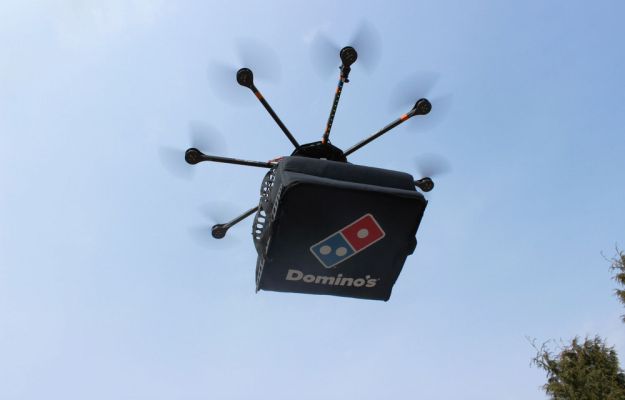Want to get your pizza freshly? Deliverer ‘Drone’ can help you!
At 11:19 a.m. 16th November 2016, Domino’s Pizza claimed the world’s first flying pizza touched down after a 5-minute flight. Then, a New Zealand couple has become the first people to have a pizza delivered by drone. Surprisingly, this successful delivery came just only 3 months after Domino’s announced a partnership with Flirtey drone delivery service. (Reid, 2016) A small team of drone experts and a GPS-navigated autonomously-controlled drone successfully dropped off the pizza. Domino’s Group CEO and Managing Director, Don Meij, said ‘drone can avoid traffic congestion and traffic lights, and safely reduce the delivery time and distance by travelling directly to customers’ homes. This is the future!’ (The Economist, 2017) So what actually is a delivery drone?
A delivery drone, is an unmanned aerial vehicle (UAV), utilized to transport food, packages, or other goods (The Economist, 2017). Many leading retail and logistics companies are currently testing drone delivery systems. Moreover, Tech giants like Amazon, Alphabet are hailing drone delivery as the future e-commerce fulfillment. As a result, drone adoption is growing rapidly among both customers and companies.
Back to 2013, Amazon has launched its Prime Air program, which aims to deliver customers’ orders within 30 minutes. In 2016, this e-commerce giant tested its first drone deliveries in the U.K. with two customers who lived nearby an Amazon fulfillment center in Cambridge. (Amazon, 2017) When the drone delivery system is mature, there’s no doubt that it will blow away its current two-day Prime shipping and two-hour Prime Now shipping. Not only would consumers receive their packages far more quickly, but also Amazon can reap the rewards of reduced delivery cost. (Meola, 2017)
However, critiques also come along. Firstly, as drones use GPS and cameras to find homes and deliver packages, consumers could raise privacy concerns. Secondly, delivery people would lose their jobs to automation. (Meola, 2017)
References:
Amazon. (2017). Amazon Prime Air. Available: https://www.amazon.com/Amazon-Prime-Air/b?node=8037720011. Last accessed 07-10-2017
Meola, A. (2017). Shop online and get your items delivery by a drone delivery service: The future Amazon and Domino’s have envisioned for us. Available: http://www.businessinsider.com/delivery-drones-market-service-2017-7?international=true&r=US&IR=T. Last accessed 07-10-2017
Reid, D. (2016). Domino’s delivers world’s first ever pizza by drone. Available: https://www.cnbc.com/2016/11/16/dominos-has-delivered-the-worlds-first-ever-pizza-by-drone-to-a-new-zealand-couple.html. Last accessed 07-10-2017
The Economist. (2017). Why the wait for delivery drones may be longer than expected. Available: https://www.economist.com/news/technology-quarterly/21723002-carrying-cargo-lot-more-complicated-carrying-camera-why-wait. Last accessed 07-10-2017


Interesting post Ting. I completely agree that drones will revolutionize delivery. Especially considering one of the largest expenses for Uber, Foodora, and Deliveroo is paying for labor, which consists primarily of delivery personnel. The main counter argument to the use of drones for delivery is that of safety, as there will likely be significant regulation in cities regarding whether drones will be able to just fly around the city. Currently, there are designated “fly zones” where drones can fly, which are usually areas outside of the city.
That’s a good point, Shaffy! Besides ‘Fly zones’, we might also need ‘Fly rules’, ‘Fly guardian’ etc.
Hi Ting, thank you for sharing this interesting article.
I really like the idea of drones being able to do what right now is done by humans in a more efficient and effective way. Yet, to be honest I’d be surprised if such disruption will happen within 2 years. The fact is that there are many drawbacks in such technology.
First of all the drone size and carrying potential. Amazon has officially stated that the goal is to create/have a drone that can carry up to 25kg for at least 10 miles. These means that either Amazon decides to at least triple the number of warehouses or the percentage of cover population will still be extremely low.
Second, the house location. While GPS and satellites allow a drone to reach the point with a very high precision, the fact that the drone has to deliver a product might be a problem. As a customer, you indeed do not want your product to be delivered (and then positioned) along the street. Unluckily with today’s technology it is the only option if the house has no garden.
Finally the legal problem: quoting The Guardian: “Current legislation means that drones cannot be flown within 50 metres of a vehicle, building or a person, or within 150 metres of a built-up area. Drones also have to remain in line of sight and within 500 metres of the pilot, which has hampered attempts to use drones for delivery or surveillance.”.
This means that in the short term is fairly unlikely that such technology will overtake more classic and standard delivery systems, but please let me know if you find reasons for a fast adoption of such technology.
Reference: https://www.theguardian.com/technology/2016/jul/29/are-drone-deliveries-a-realistic-prospect
Hi Marco,
Thanks for reading and making such a well-considered comment. Yes, I do agree with your point that the drone technology is still immature and may take quite some time to be readily used in general public. However, don’t underestimate the speed of technology development. We never know 🙂
Hi Ting, thank you for your article. This would be a very good idea in big cities where traffic is super bad. This would cut down travel time and will make sure that my pizza is fresh and warm when I receive it. HMMMHH Getting hungry already! Great!
Also excited for it hahaha